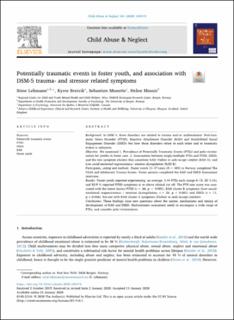Potentially traumatic events in foster youth, and association with DSM -5 trauma- and stressor related symptoms
Journal article, Peer reviewed
Published version

Åpne
Permanent lenke
https://hdl.handle.net/11250/2753892Utgivelsesdato
2020Metadata
Vis full innførselSamlinger
Originalversjon
International Journal of Child Abuse & Neglect. 2020, 101, 104374 https://doi.org/10.1016/j.chiabu.2020.104374Sammendrag
Background
In DSM 5, three disorders are related to trauma and/or maltreatment: Post-traumatic Stress Disorder (PTSD), Reactive Attachment Disorder (RAD) and Disinhibited Social Engagement Disorder (DSED) but how these disorders relate to each other and to traumatic events is unknown.
Objective
We examined 1. Prevalence of Potentially Traumatic Events (PTEs) and poly-victimization for youths in foster care. 2. Associations between single/multiple PTEs and PTSD, DSED, and the two symptom-clusters that constitute RAD: Failure to seek/accept comfort (RAD A), and Low social-emotional responsiveness/ emotion dysregulation (RAD B).
Participants, setting and methods
Foster youth 11–17 years (N = 303) in Norway completed The Child and Adolescent Trauma Screen. Foster parents completed the RAD and DSED Assessment interview.
Results
Foster youth reported experiencing, on average, 3.44 PTEs each (range 0–15, SD 3.33), and 52.9 % reported PTSD symptoms at or above clinical cut off. The PTE sum score was associated with the latent factors PTSD (r = .66, p < 0.001), RAD cluster B symptoms (Low social-emotional responsiveness / emotion dysregulation, r = .28, p < 0.001) and DSED (r = .11, p = 0.046), but not with RAD cluster A symptoms (Failure to seek/accept comfort).
Conclusions
These findings raise new questions about the nature, mechanisms and timing of development of RAD and DSED. Maltreatment assessment needs to encompass a wide range of PTEs, and consider poly-victimization.
